Whether you’re a seasoned mycologist or you only know mushrooms from grocery stores and Super Mario, cultivating them at home is a convenient, fun, and rewarding way to see just how amazing fungi are.
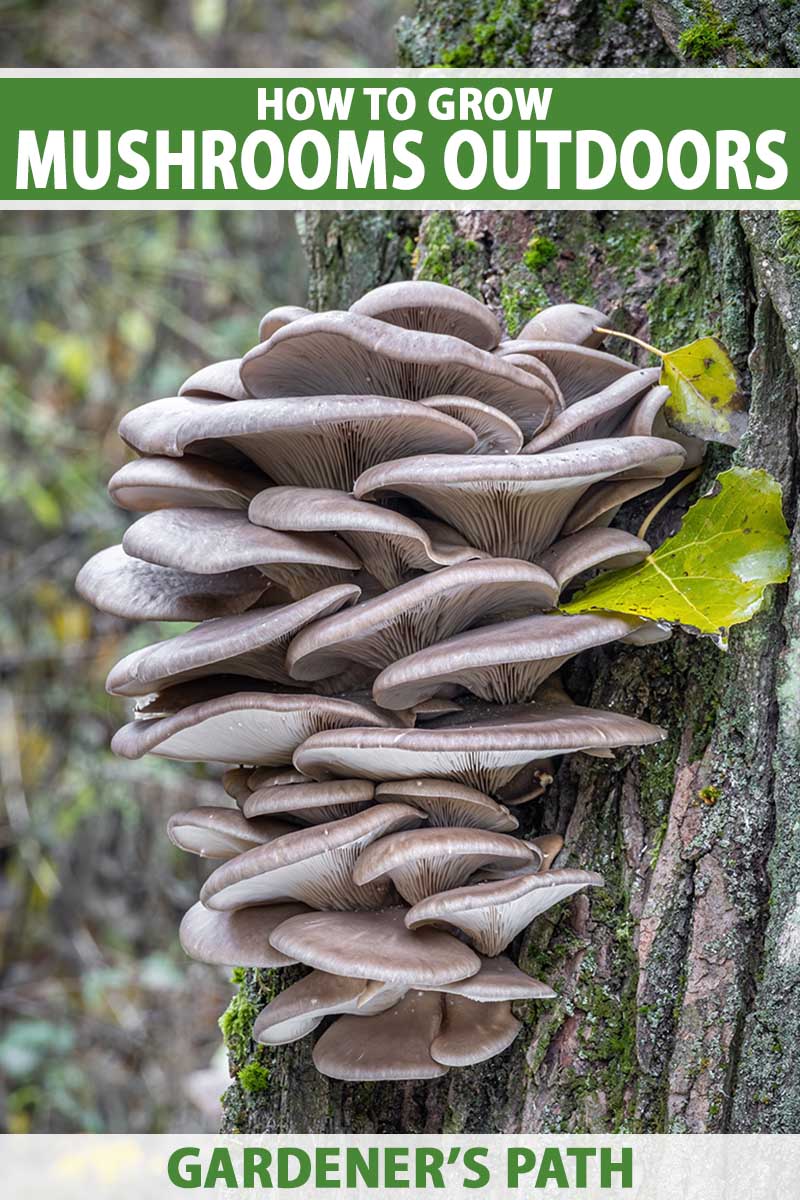
We link to vendors to help you find relevant products. If you buy from one of our links, we may earn a commission.
Maybe you need more ’shrooms than the ones you find foraging on long hikes.
Or perhaps you’re a fan of a particular kind of mushroom, but can never find it at your local grocery store or farmers market.
Whatever the reason, growing your own colony of mushrooms is a good idea.
And with just a few tools, spawn plugs, and the proper growing medium, you’ll be well on your way to witnessing something truly magical, right in your own yard.
Our guide to growing mushrooms outdoors has all the know-how you’ll need for spawning your own fabulous fungi.
And who knows? Maybe this will serve as your gateway to becoming a hardcore mycophile!
Here’s what we’ll be discussing:
What You’ll Learn
Let’s dive in, shall we?
Mushrooms 101
We can’t talk about mushrooms without discussing fungi… and they’re not exactly the same thing.
You see, mushrooms are the fruiting bodies of fungi. All mushrooms are fungi, but not all fungi are mushrooms.
There are millions of species of fungi, while the amount of known mushroom species are in the (relatively) mere thousands.
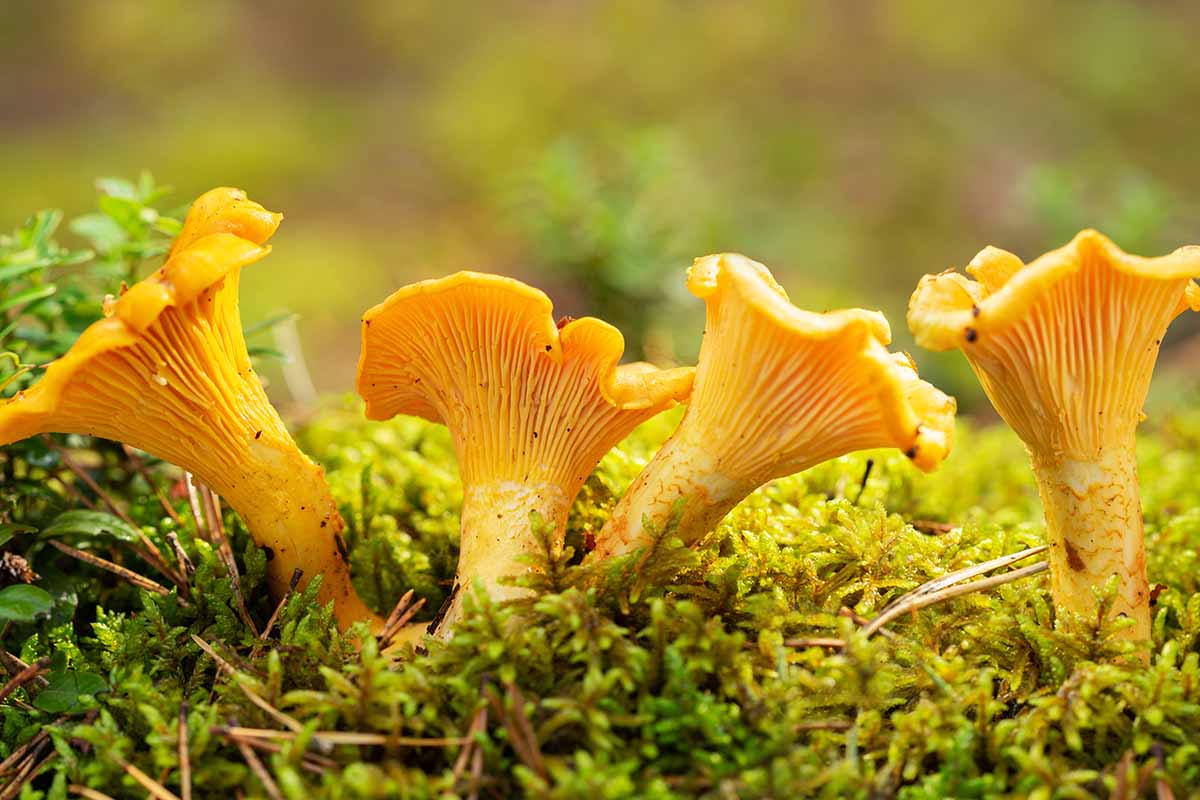
For a long while, fungi were assumed to be plants, and were thus described as part of the plant kingdom.
But they eventually gained their own taxonomic kingdom once scientists determined that fungi are as dissimilar to plants as they are animals, if not more so.
Like plants, fungi have eukaryotic cells enclosed in cell walls and are mostly incapable of physical movement, with growth and reproductive spread being their primary means of mobility.
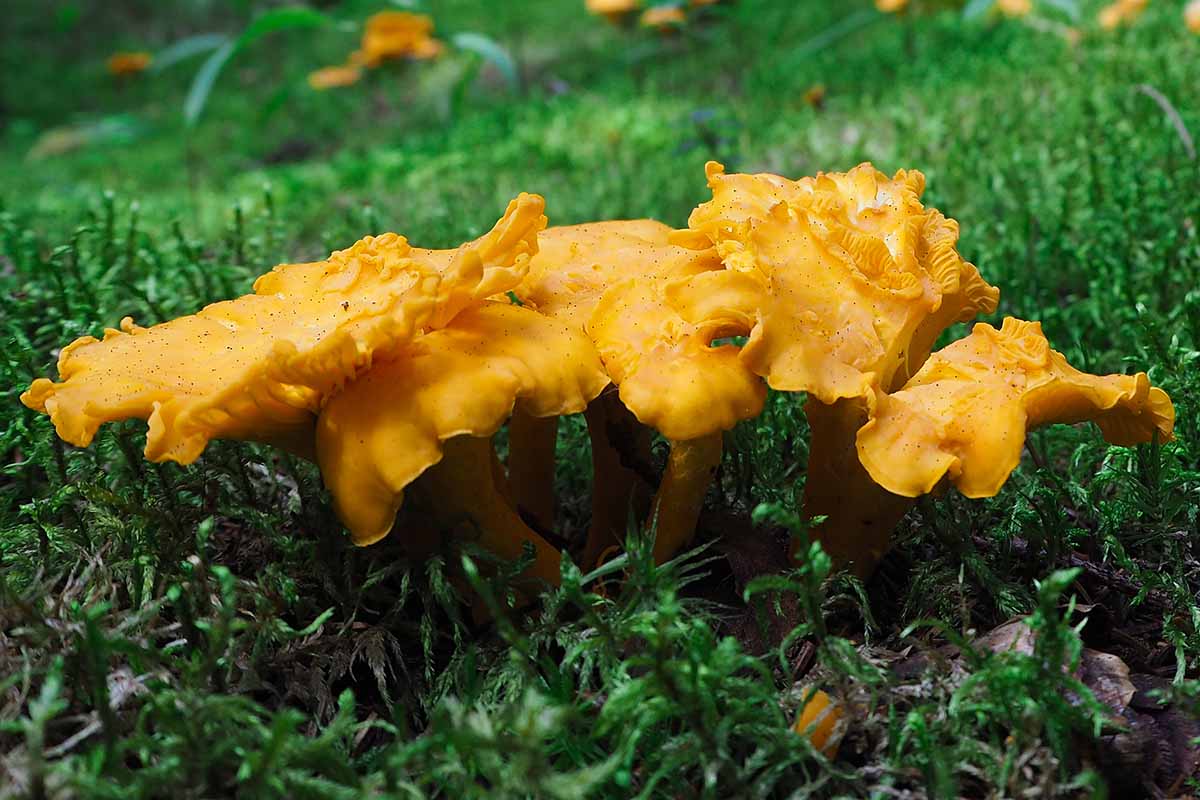
But unlike plants, fungi have cell walls composed of chitin, rather than cellulose.
And more importantly, they are incapable of photosynthesis, and thus have to obtain their energy from other living things, much like animals do.
To do this, they grow filamentous hyphae as part of a root-like structure known as mycelium.
The mycelium acts as an anchor for the fungus, and the hyphae secrete enzymes that break down decaying organic matter for easy absorption. Fungi must grow in the right spot to access this organic matter, such as on a rotting log or in humus-rich soil.
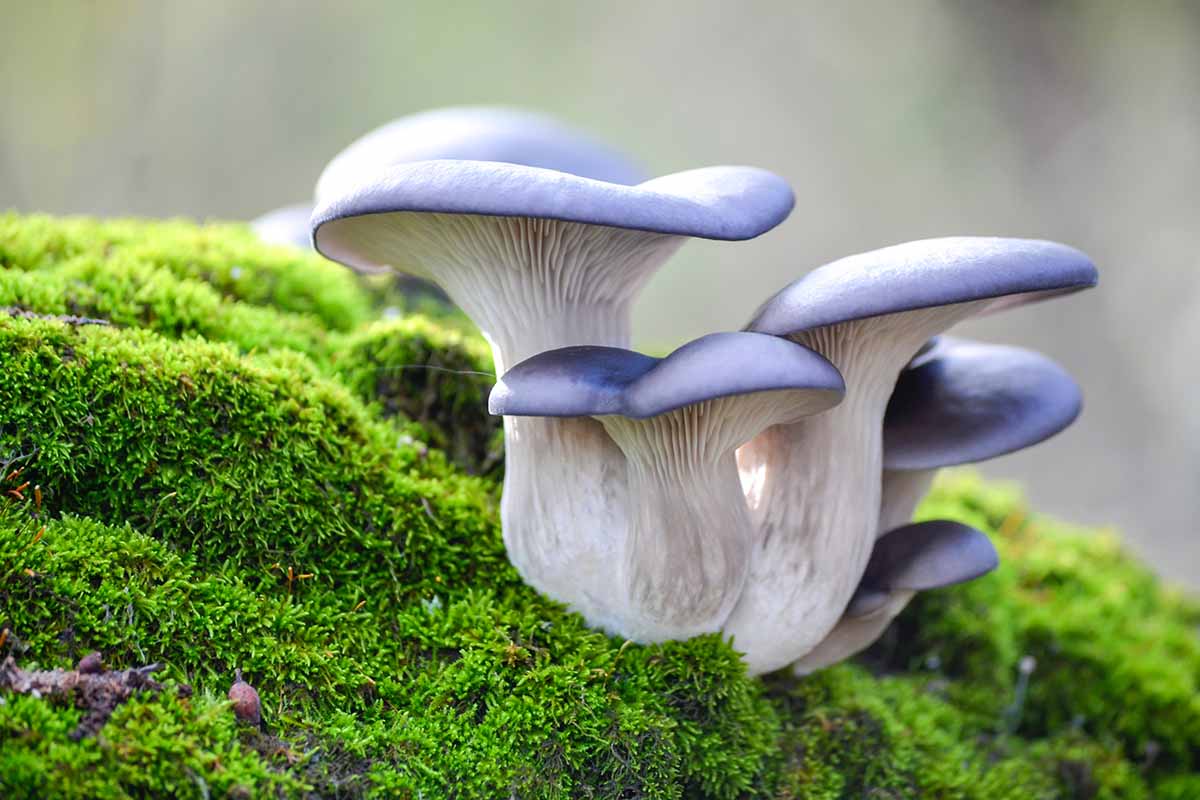
The term “mushroom” refers to the fruiting bodies of certain types of fungi.
These have distinctive, sometimes toadstool-esque stalks and caps, rather than molds, yeasts, and mildews. Ya know, something a Smurf might wanna live in.
Shiitake, oyster, turkey tail, reishi, lion’s mane, chanterelle, chicken of the woods…
There are many edible and delicious mushrooms out there, with various flavors and nutritional or medicinal benefits.
But many others are quite dangerous to consume – some have enough poison to drop a five-ton elephant to its knees in 10 seconds or less.
Given the danger of some species, foraging for wild mushrooms can be a risky hobby.
It’s super satisfying when done successfully with an experienced guide, but amateurs in particular are always just one wrong identification away from a potentially fatal forage.
And it can be pretty easy to mistake a poisonous species from a similar-looking edible one in some cases.

For example, this is a chanterelle, a well-known and delicious species used in cooking all over the world.
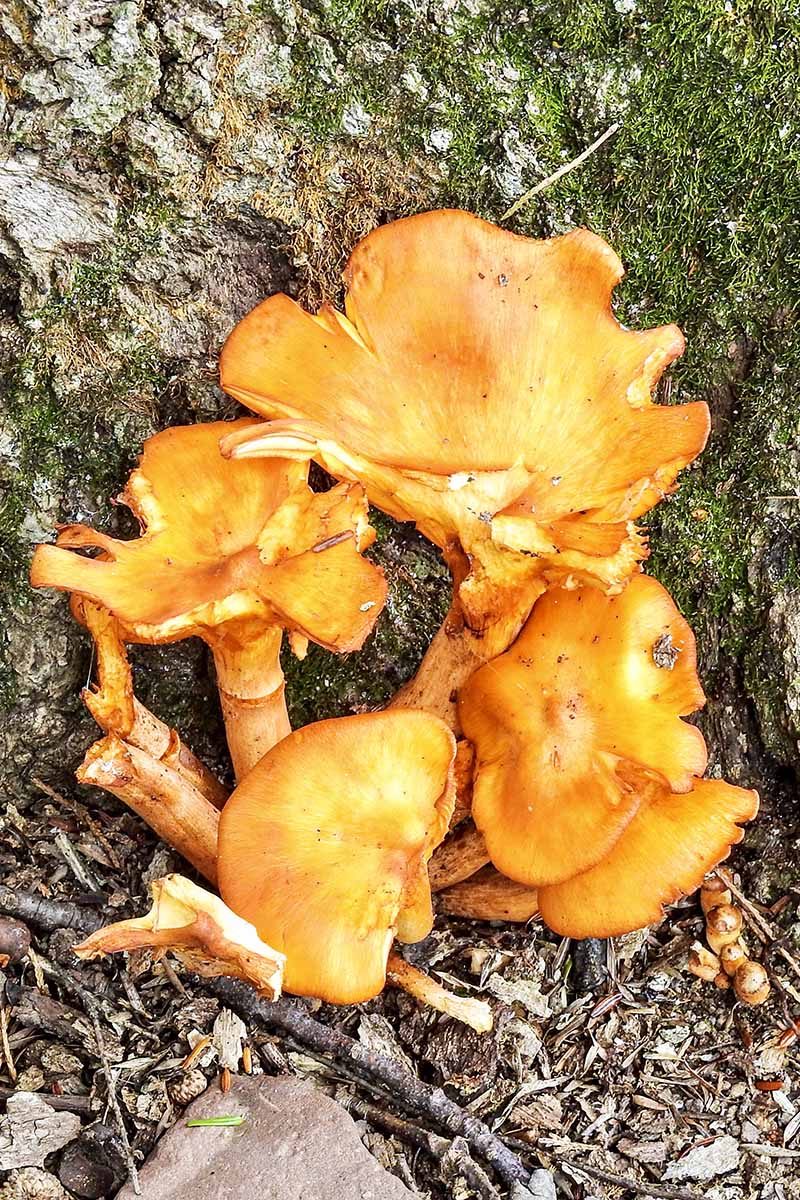
In contrast, this is false chanterelle, which is poisonous and inedible.
I know, right? You can see how easy it is to confuse the two in the wild and potentially end up with the poisonous one for dinner!
So whatever you do, you must be prepared.
If you choose to go foraging for fungi, carry your identification book with you, bring along a friend who’s good at fungal identification, and spend copious amounts of time examining each variety you find to ensure that it isn’t poisonous.
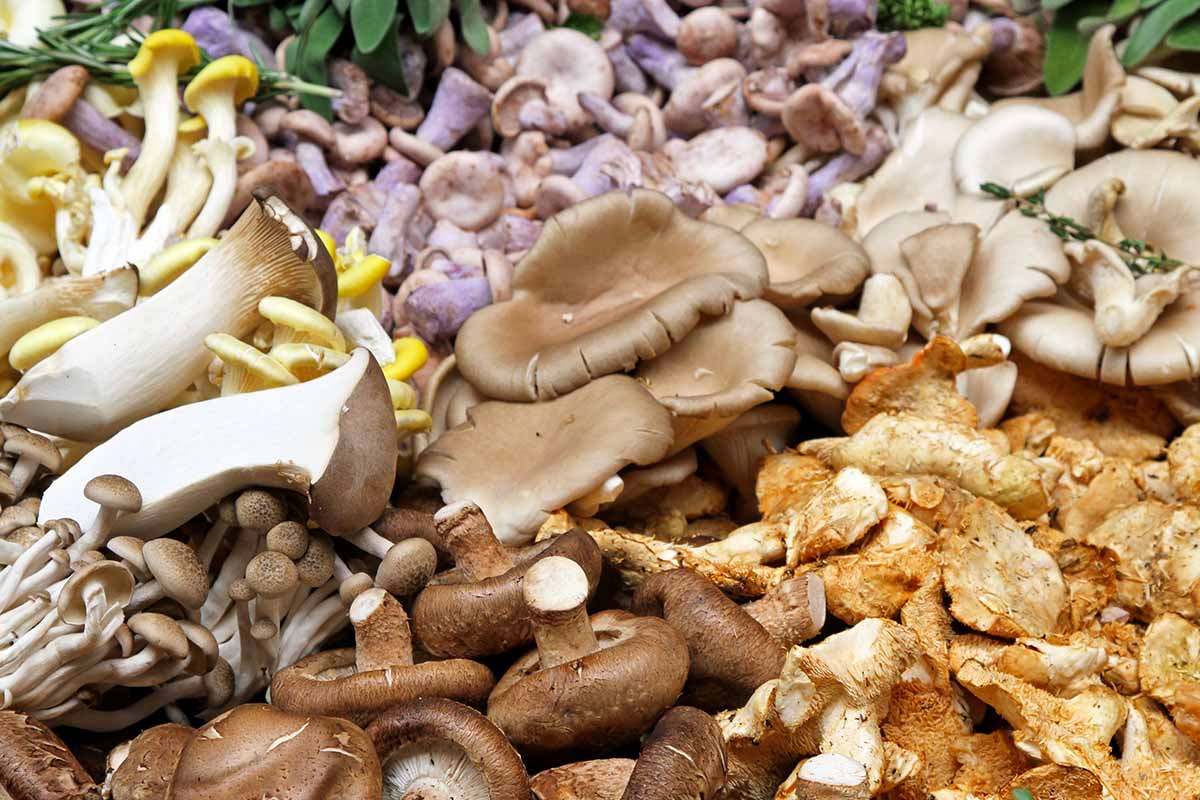
Alternatively, you could simply grow mushrooms yourself. And that is hopefully what’s brought you here!
Doing so allows you to choose the species, go as large or small in scale as you’d like, and always have your yields close by.
What You’ll Need
So, you’ve decided to take the plunge into the world of home fungiculture. Congratulations! But before you begin, you’re gonna need a couple of things.
But before we dive into that, we should touch on the process of mushroom reproduction.

Mushrooms aren’t plants, so you can’t expect to grow them by sowing seeds or taking cuttings.
Instead, they make like ferns and reproduce via spores, which spread far and wide by hitching a ride on wind, water, or even animals until they land on a surface upon which they can grow.
Spore germination is unpredictable and difficult to reliably pull off, especially for amateurs.
In specialized facilities, professionals germinate spores and provide them with a substrate such as grain, agar, or some other culture media to propagate pure mycelium.
This cultivated mycelium is known as spawn, and it’s perfect for home growers to use.
Spawn
When searching for spawn, seek out a reputable vendor who can provide high-quality spawn for your choice of variety, along with any information that you might need for cultivation.
You can also check with local fungi farms, where they might give you some leftover spawn that they would otherwise throw away.
As far as what to look for, cultural requirements-wise, you have a bit more flexibility than you might with plants.
Mushrooms usually grow best in warm, humid, and moist conditions, yet fungal species tend to have a rather broad hardiness range.
Indoor cultivators looking to maximize production do so by controlling humidity and temperatures within a tight range, but outdoor growers don’t have the luxury of precise climate control.
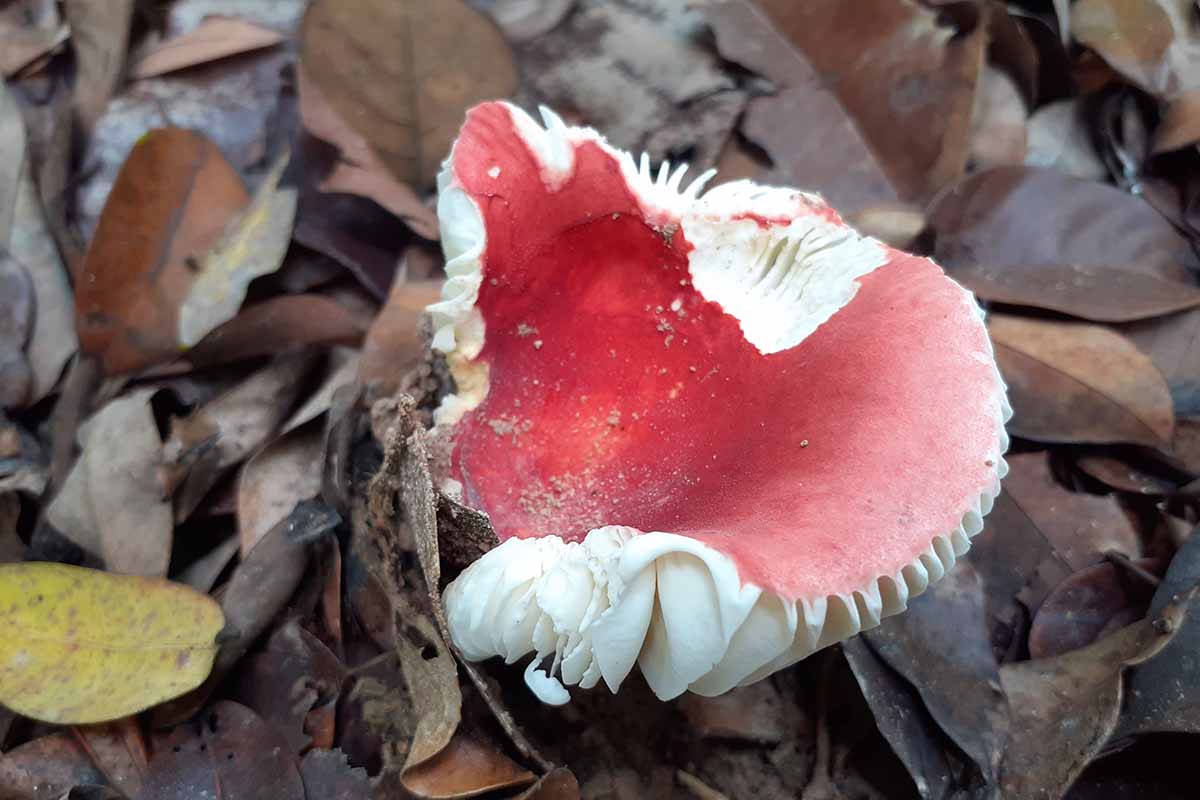
Depending on the species, mushrooms can survive year after year in a variety of temperatures.
You should be able to find a species that’ll grow in your garden for many years, provided that your garden isn’t regularly subjected to scorching heat or blistering cold.
Believe it or not, they actually have light needs, too. Not for food production – photosynthesis is a plant thing.
But the right amount of light exposure does help the fungi develop those delicious fruiting bodies necessary for reproduction, aka the tasty mushrooms that we’re after to eat.
So pay attention to the light preferences of your chosen species and the exposure that your growing site will receive.
There are many, many types of edible mushrooms, from shiitake to porcini, and reishi to blue chanterelle. Do your research to find out which types you prefer to eat and what their growing habits are.
You’ll also find many excellent reference books out there.
One such text is “The Mushroom Cultivator: A Practical Guide to Growing Mushrooms at Home,” by Paul Stamets and J. S. Chilton.

It provides a comprehensive approach to the cultivation, harvesting, and use of these fungi, and is available in paperback or Kindle format on Amazon.
If you choose to grow in a mushroom bed, seek out spawn in grain or sawdust form.
If you plan to use logs, look for spawn plugs, which are compact enough and shaped in such a way to fit snugly inside pre-drilled holes.
Gardener’s Supply Co. has almond mushroom sawdust spawn available, as well as sawdust spawn for wine cap mushrooms.
Substrate
You can cultivate your spawn atop a bed of organic matter such as straw, woodchips, or compost, or you can inoculate wood logs or stumps with it.
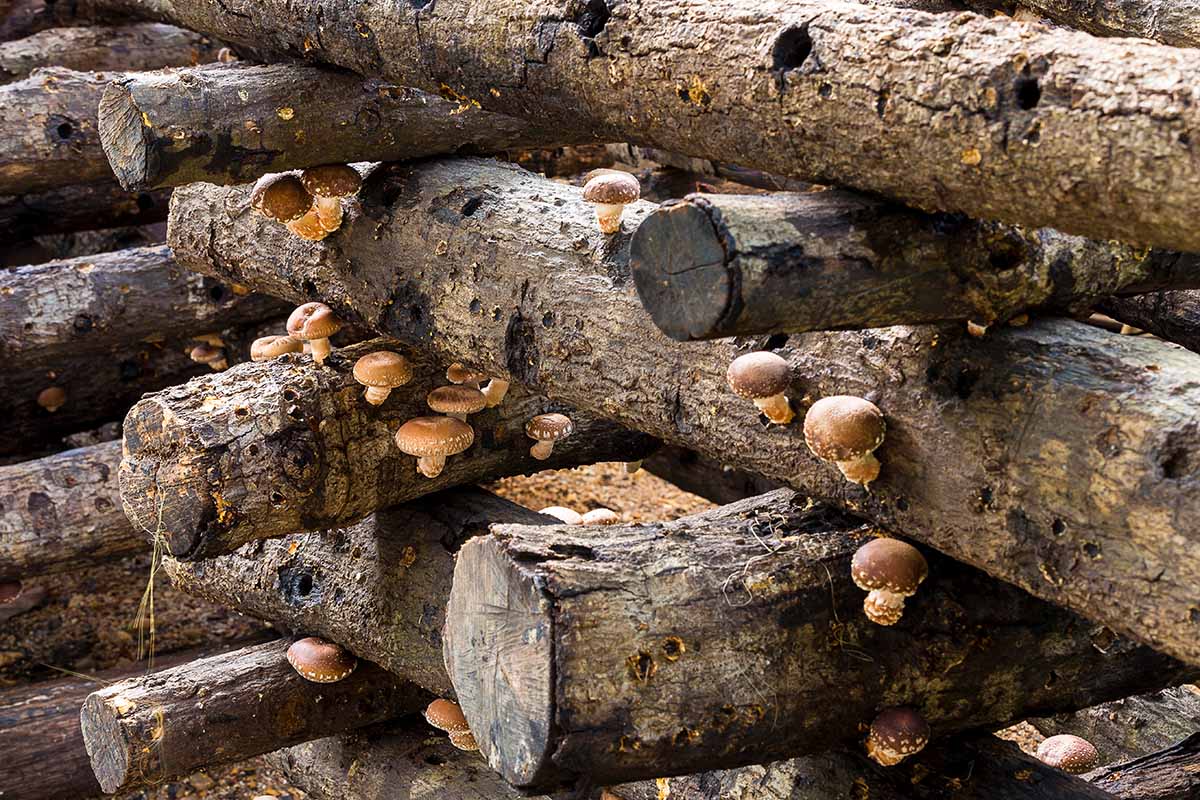
Any selected organic matter should be fresh and unblemished, with no other fungal bodies present. Remember, we’re providing food for this fungus, and it shouldn’t have to compete with other organisms for it.
If you go the lumber route, you should know that certain mushrooms grow better on or in certain types of wood.
Some fungi prefer hardwoods such as oak, maple, or elm, while others grow better on softwoods like pine, spruce, and fir.
Keep the species you wish to grow in mind as you research what kind of wood you need. It’s important to find the right match to ensure proper growth and an ample harvest.
Another important thing to mention is that the logs for cultivation must be recently cut, and they must come from healthy trees.
They need to be free of any lichen or fungal growth, and show no signs of deterioration or discoloration. It is essential for the spawn to live in and colonize healthy wood.
Wood-wise, you’ll want to use fresh stumps and/or logs in three- to four-foot lengths.
For clarification, stumps are the basal sections of tree trunks with a tapered flare to their bottoms, and possibly attached root systems, whereas logs are your more stereotypical sections of cut lumber.
After cutting, be sure to let them sit in a dry place for about two to three weeks.
But don’t wait too much longer – you cannot inoculate cut logs and stumps that are more than six months old, as they may already have lichen and fungus inhabiting them.
Tools and Supplies
Next, gather your tools and supplies. You don’t need much, but certain items are important.
For growing in beds, a raised bed might be nice for accessibility, but it’s not necessary. A mound of organic matter placed on the ground works just fine, too.
If you go with wood, you’ll need some additional equipment.
This includes a drill for creating the holes that the plugs will go into, along with an accompanying drill bit that’s the approximate diameter of your plugs.

This battery-powered drill from Avid Power comes with 10 different drill bits and is available in four different colors on Amazon.
You’ll also require a rubber mallet, to help jam the plugs into the drilled holes.

American Soil Organics Soy Wax Beads
A soy-based wax, applied via a small foam paint brush, should help to keep the plugs in place. American Soil Organics sells five-pound bags of soy wax via Amazon.
How to Grow Mushrooms
Generally, any point from spring to fall is a great time to start growing mushrooms.
Although some species are winter-loving… so technically, with the right species, you can start them all year long.
If you’re growing in beds, then you’ll need to prepare them first.
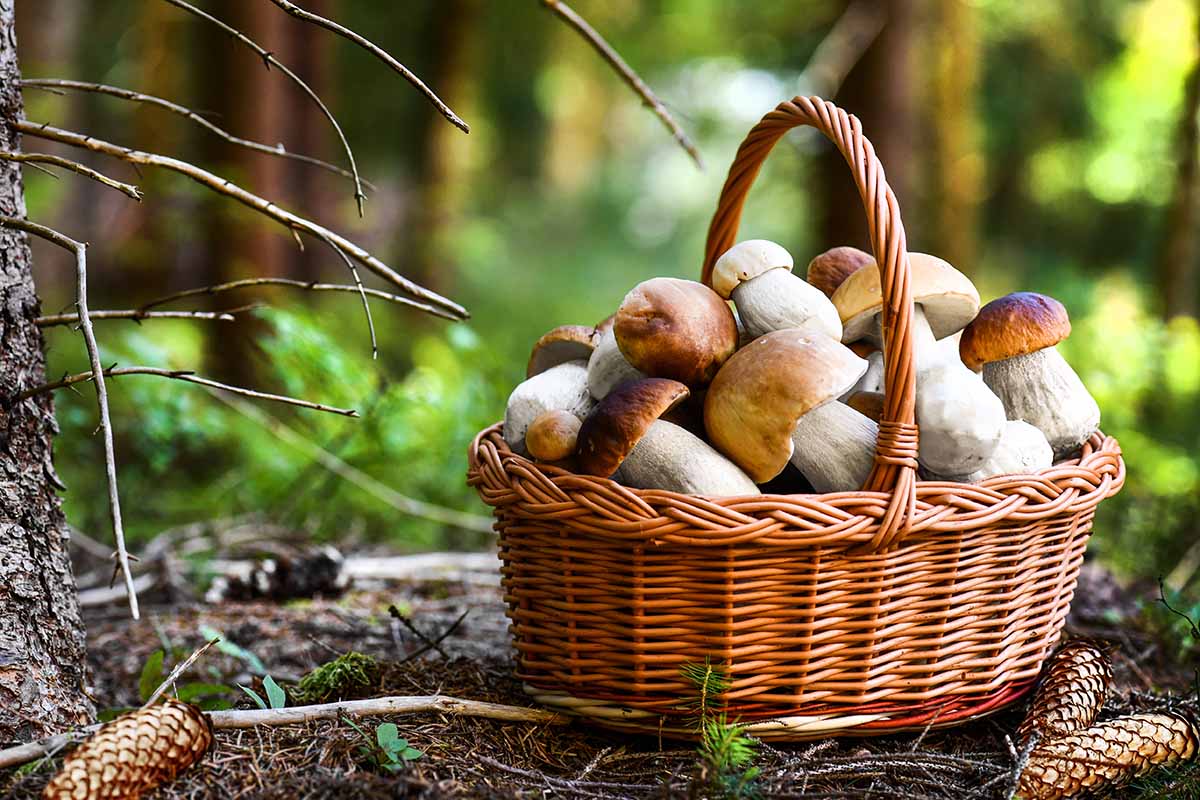
Atop either in-ground garden soil or the soil in a raised bed, add a couple inches of organic matter such as straw or wood chips. Organic matter preferences vary from species to species, so make your selections accordingly.
Then sprinkle the spawn over the layer that you just put down. Any chunks of spawn should be crumbled as you spread it to make growth easier. Once your spawn is spread, add a couple inches of organic matter on top as a protective layer.
Keep the bed moist, and presto! You’re on your growing way.
For growing in lumber, you’ll first have to drill the holes that the plugs will go into.
If you have chosen a newly cut stump, use your drill and drill bit to bore holes all around the top and sides of the stump.
Make the holes 1.25 inches deep to create enough space for each plug to fit snugly into. A stump of the recommended size described above will usually hold up to 50 plugs.
If you are using logs, drill 1.25 inch-deep holes all along the length in rows, spaced at least an inch apart. Again, 50 plugs per one three- to four-foot log should suffice.
To inoculate your wood, start by grabbing your spawn plugs. Sometimes they will look fuzzy, which is just the mycelium growing and colonizing the wooden dowels. It’s also a sign that the spawn is healthy and ready to start consuming your logs or stumps.
Grab your mallet and a plug. Set the tip of the plug in one of the holes and gently tap it into place, making sure to get the entire plug in there.

The plugs are soft, so they might squish sometimes. Don’t sweat it – as long as that spawn plug fits entirely into the hole, it’ll work. Repeat with the remaining plugs until they’re all inserted.
The next step is to cover the holes with wax, which helps to keep the mycelium safe, clean, and protected.
Heat up a small amount of your soy wax, either in a double boiler on the stove or in the microwave. Immediately after heating, use the small foam paint brush to cover each hole with hot wax.
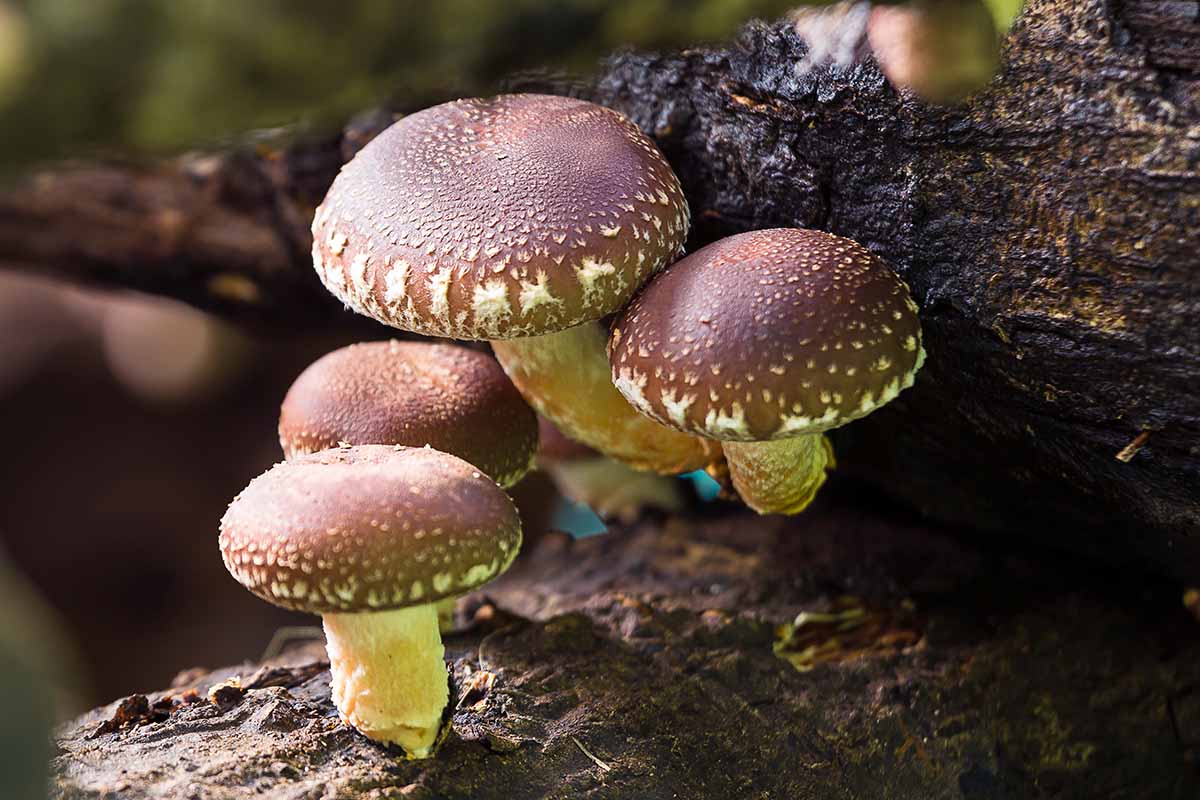
If you are using logs, you can arrange them in sturdy three-foot stacks like Lincoln Logs or prop them up against something, such as a wall or shed.
Either way they just need ventilation and ample opportunity to absorb moisture.
You should also place them in a spot that’s at least partially shaded – i.e. that receives sun for only three to six hours per day – so they won’t dry out too quickly. Such a place could be under a stand of evergreen trees, for example.
During the beginning phase of this process, when the spawn is slowly colonizing its new home moisture is critical.
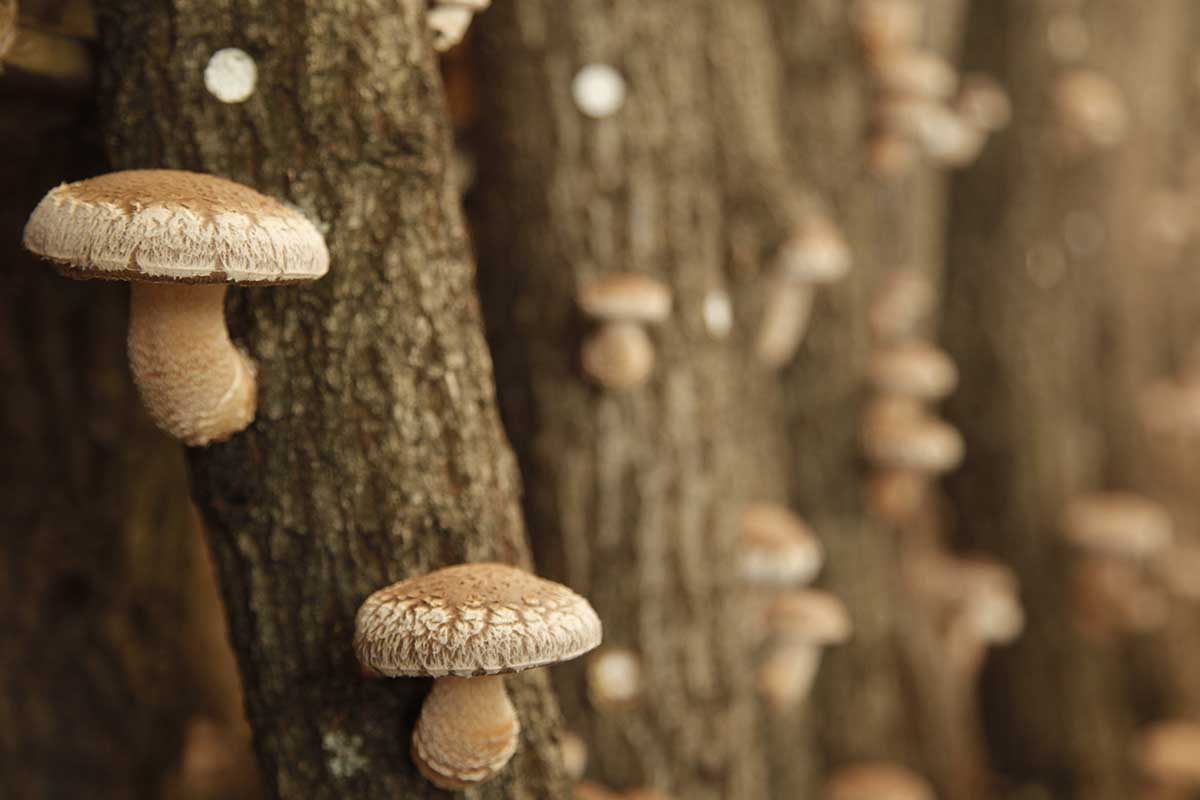
When watering your logs or stumps, you need to do so until you see that the wood has absorbed the moisture enough to lose its appearance of crispy dryness.
Depending on the ambient humidity, you may need to keep watering indefinitely, or as often as it takes to keep the logs from drying out.
Mushrooms generally grow very slowly. Cultivating them outdoors takes longer than growing them indoors because you can’t really control the exposure and ambient climate like you could inside.
Depending upon the variety that you choose to grow, you could see evidence of growth in as little as six months or it may take as long as two years. It’s a slow process, but it’s oh so worth it.
Keep in mind that a fungal colony can live for years when it’s healthy and thriving, so it’ll be well worth the wait.
Quick Tips
- Whether you use logs, stumps, or a bed of organic matter, keep the growing substrate moist.
- Provide partial sun, unless your specific variety calls for a different exposure.
- Don’t forget to provide ventilation.
Mushroom Varieties to Select
If you’ve never grown mushrooms before, it can be tough to choose a variety to start with.
If you’re in need of suggestions, then this trio of varieties offers a solid selection to kick off your new fungiculture hobby with.
Lion’s Mane
Also known as the hedgehog mushroom, lion’s mane, aka Hericium erinaceus, takes a delightful detour from the stereotypical mushroom aesthetic.

These white, three- to 10-inch-wide mushrooms sport long, dangling spindles.
These have a history of application in gourmet cooking and in traditional medicine, offering brain-boosting nutrition.
Oyster
Known to grow robustly in many different climates, Pleurotus ostreatus is often the go-to recommendation for newbie mycophiles.
With white to tan hues and oyster-shaped caps up to six inches wide, these tasty mushrooms are absolutely iconic.
For help in kick-starting the growing process, here’s a 12-inch elm log that’s been pre-inoculated with phoenix oyster spawn, available from Terrain.
Shiitake
Shiitake is another popular, easy-to-grow option.
With tan to brown hues, stout stems, and rounded caps that spread up to four inches wide, Lentinus edodes is easy to recognize and even easier to love.
Plus, uttering their common name is an effective way to avoid an accidental full-on swear, provided you think fast enough.
If you’re interested, here’s a pre-inoculated, one-foot-long shiitake log, available from Terrain.
Harvesting and Preservation Tips
At various stages of your fungiculture journey, you’ll have delicious-looking mushrooms that are just begging to be harvested. You’ll harvest them before the caps flatten out and release their spores.
If the spores release, it can significantly alter a cap’s flavor and texture, rendering it unpalatable if not inedible.
But before you actually harvest, double-check that your fungi are indeed your intended species, as other ones can naturally pop up. Wouldn’t want a poisonous yield on your hands!
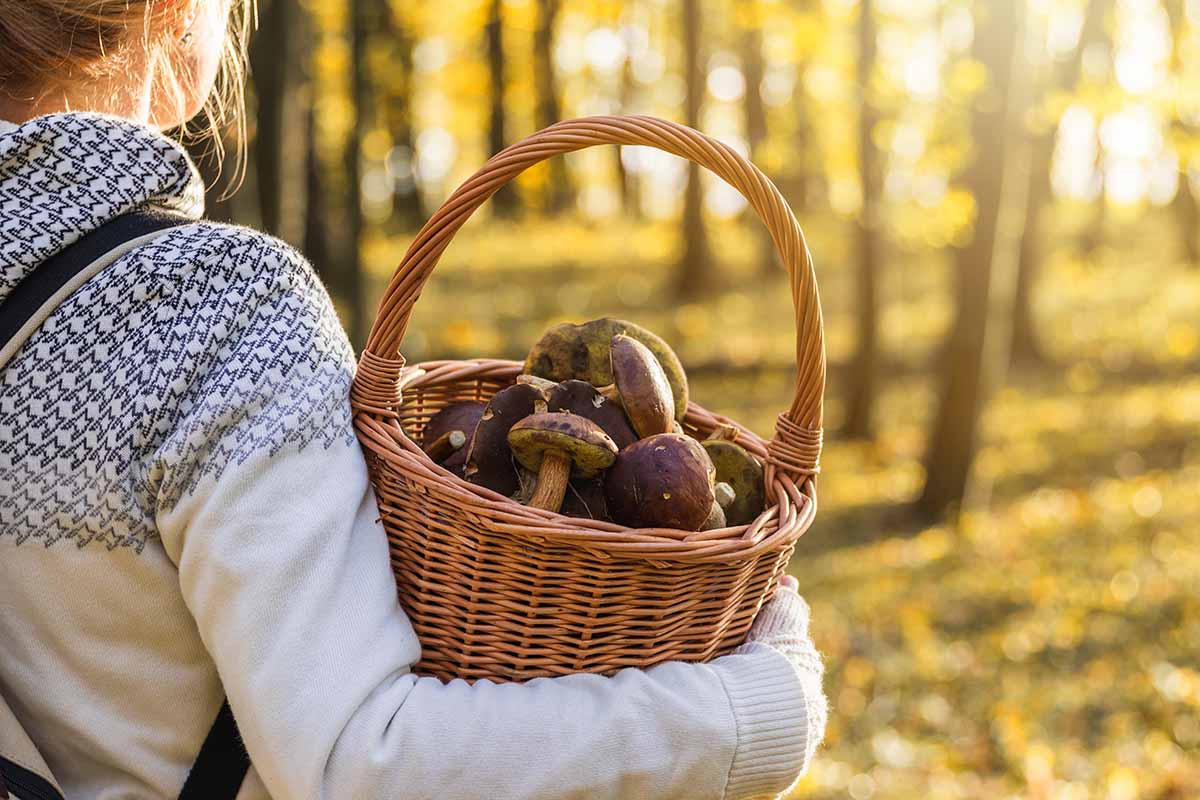
Once you’ve determined that you’re about to harvest what you intended to, it’s as simple as grabbing under the cap, twisting, and pulling gently.
You can use your mushrooms right after harvesting them. If cleaning is necessary, do so by wiping them down with a dry cloth, as rinsing with water can leave them soggy.
If you’re not yet ready to use them, harvested mushrooms can be placed in a brown paper bag and stored in the fridge, where they’ll be good to eat for about a week.
Recipes
Now that you have some delicious mushrooms on hand, your culinary options abound! Here are a few delicious recipes for your culinary pleasure.
Broiled Salmon with Shiitake Mushrooms and Parmesan Grits
This delicious and nutritious meal has something for everyone: salmon for seafood lovers, cheesy grits for fans of Southern cuisine, and shiitake mushrooms for our culinary mycophiles.
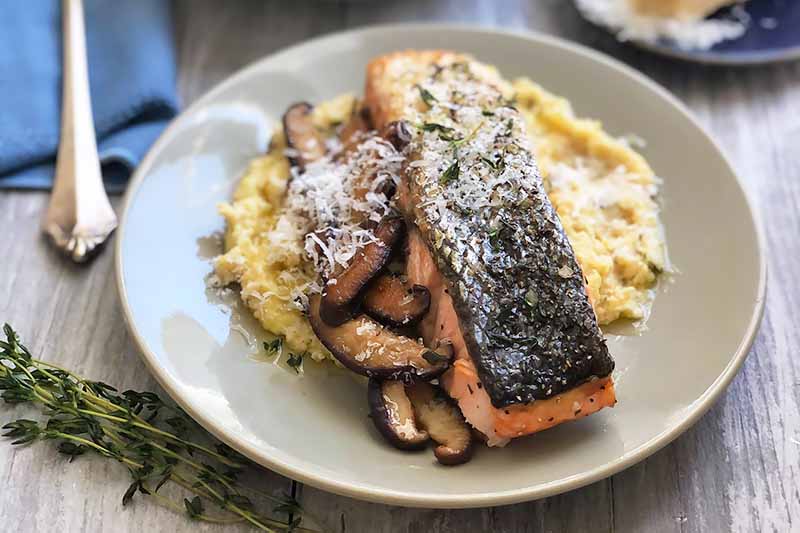
As I type this, I’m trying to keep my salivation in check, lest I short-circuit my keyboard.
This recipe is available on our sister site, Foodal.
Flavorful Sauteed Mushrooms
Looking for a delicious way to prepare button mushrooms?
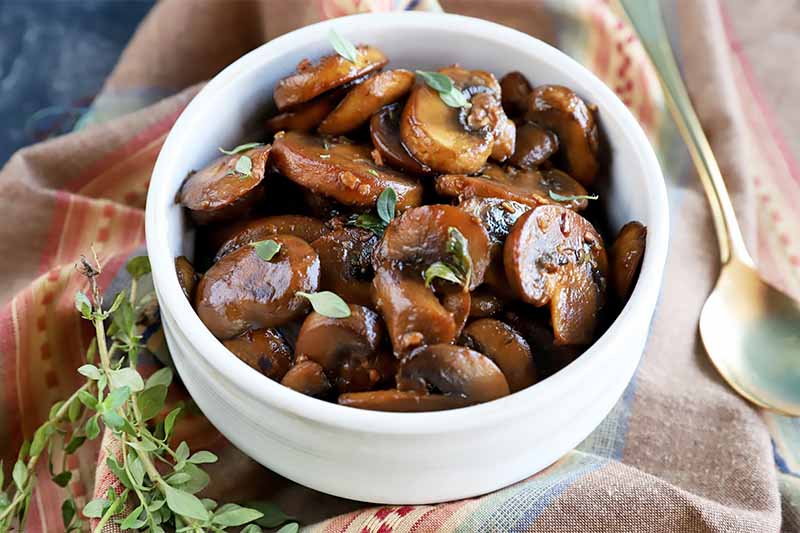
This recipe will help you whip up a delectable addition to many other dishes, from pizzas to pastas. It’s available via Foodal.
Stuffed Mushrooms with Cheese and Breadcrumbs
In need of some finger food to bust out at a party? Lo and behold this cheese-and-breadcrumb-stuffed recipe.
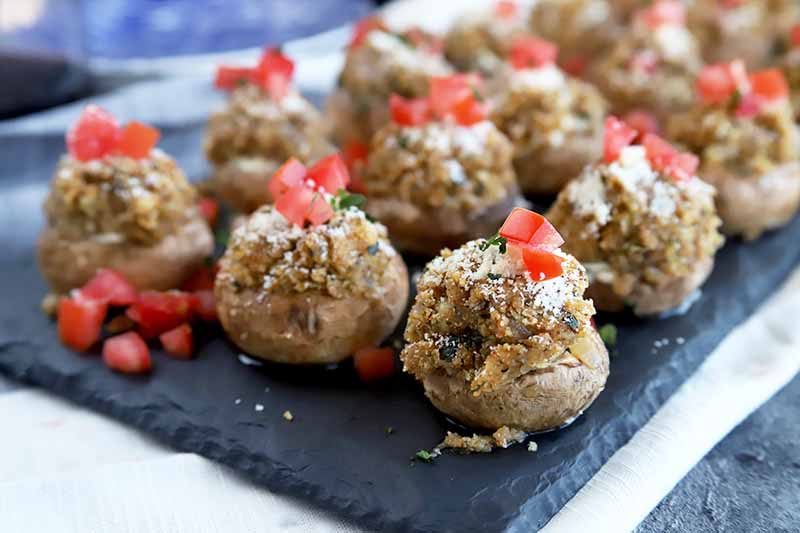
Add freshly chopped tomatoes on top as a contrast to the cheesy bread filling, and you have a savory treat that’ll have you going back for seconds, if not thirds and fourths.
Check out how to make them on Foodal.
Quick Reference Guide
| Organism Type: | Edible fungi | Propagation: | Spawn (plugs or sawdust) |
| Native to: | Worldwide | Substrate: | Logs, sawdust, straw, woodchips |
| Hardiness (USDA Zones): | 2-12, depending on species | Maintenance: | Moderate |
| Time to Maturity: | 6 months - 2 years | Water Needs: | High |
| Exposure: | Part shade | Subkingdom: | Dikarya |
| Growth Rate: | Slow | Phyla: | Ascomycota, Basidiomycota |
Make Room for Some ’Shrooms
If your garden is exclusively filled with plants, I’d definitely set aside some space for their fungal friends.
Tasty and easy to grow for years to come, edible mushrooms should be a staple for anyone looking to grow their own food.
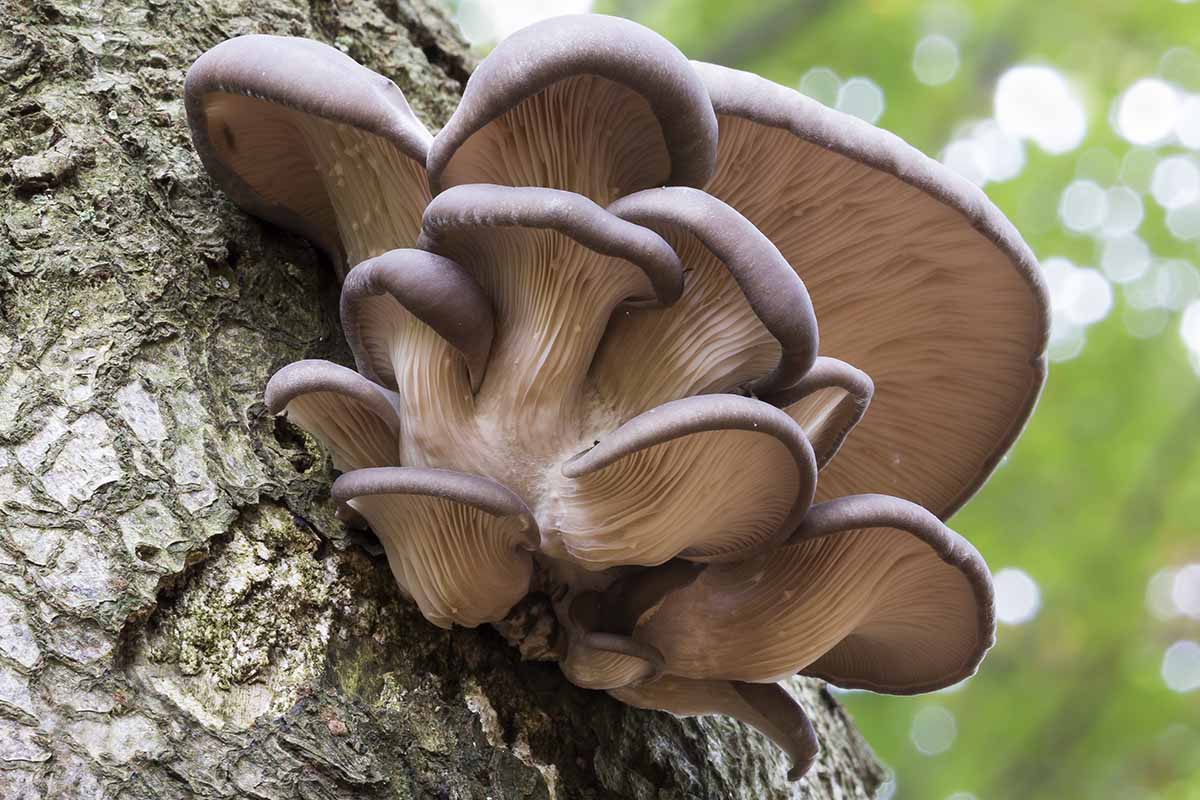
Have fun experimenting with the taste of different varieties! And of course, don’t forget to be safe and mindful about what species you choose to cultivate.
What type of mushrooms do you want to grow at home? If you’ve tried it before, what are your favorite methods, and what are some setbacks that you faced? Tell us your stories in the comments below, we’d love to hear them!
Trying to learn how to grow more edible plants in the landscape? For the mental munching, here are some growing guides for vegetables that actually go great with mushrooms:
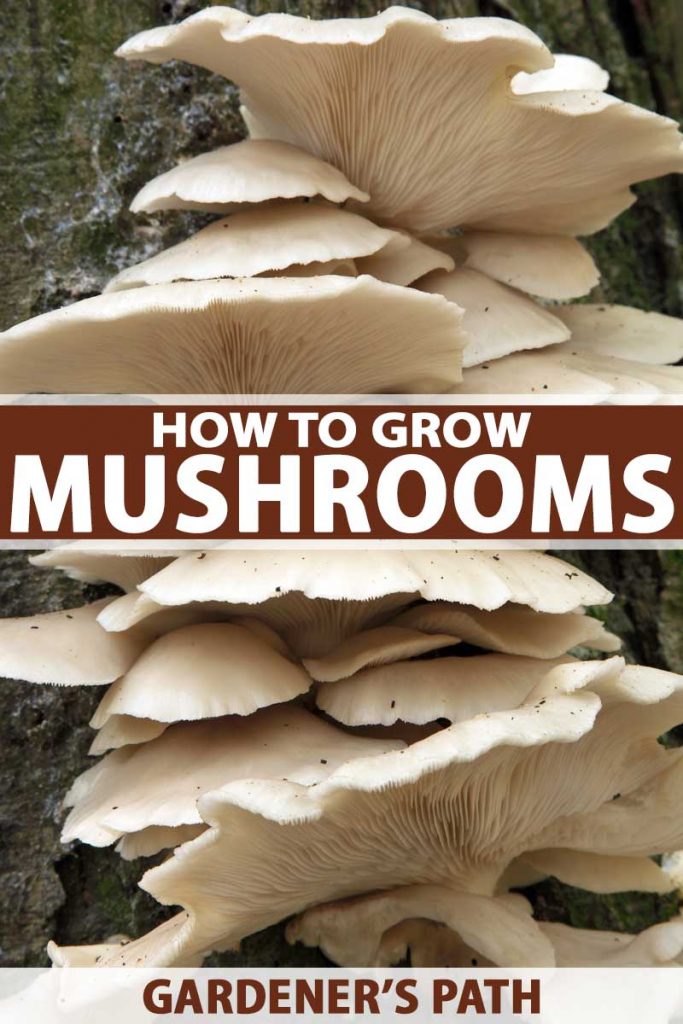
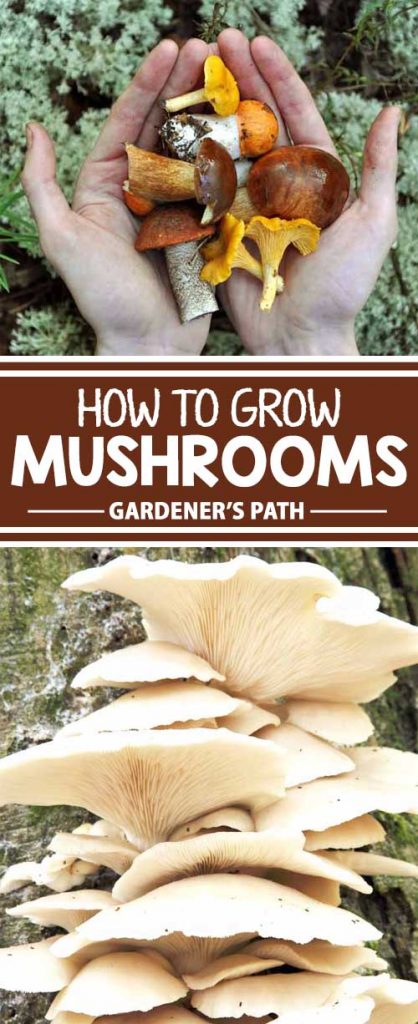
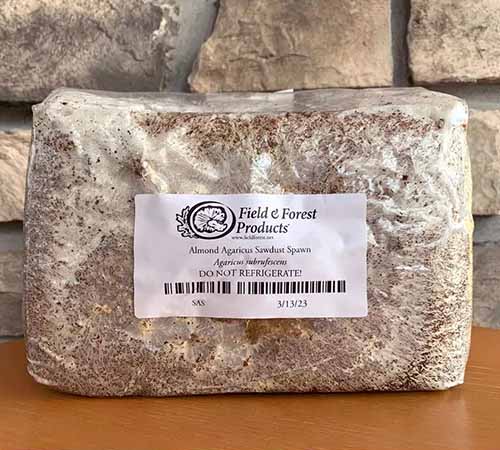
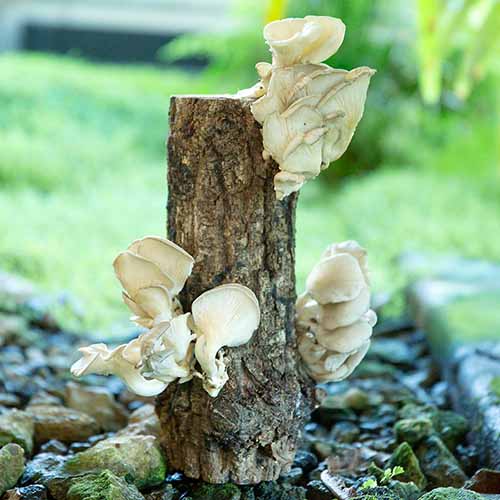

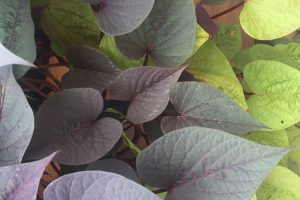
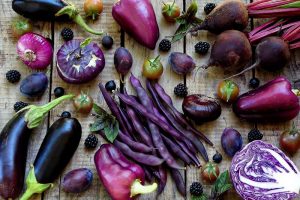
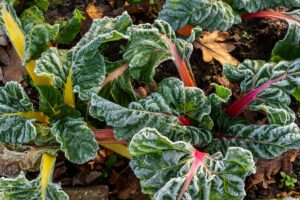
Thank you for sharing the how to’s in growing this
amazing plant. I will start my own garden soon.
Good luck, David. Glad we were able to help!
Mushrooms are not a PLANT but rather a fungus.
You are correct, they are member of the kingdom of fungi rather than the plant kingdom. We’ve listed them under plants > vegetables on our website since we do not currently have a separate category for fungi, and edible ones are typically eaten in the same fashion as vegetables. ????
no need to yell lol. people love to learn, so just tell them without the caps. you will come across as helpful rather than condescending.
fantastic article! many thanks!
Thank you for this intro to growing mushrooms.
You’re welcome, Blake! Thanks for reading!
This article is great! I am excited to try. Would you please recommend a reputable mushroom spawn or plugs vendor? The Fungi Perfecti you mentioned ended up being mostly mushroom supplements. And I like all mushrooms but love shiitake, chanterelle and porcini. Are they easy to grow? Do I need a log for each variety? I don’t have much space. Chicken of the woods sounds delicious but I never had them before. Thank you so much and look forward to hearing back from you!
Thanks Limin! Where are you located/what growing zone are you in? I grew up near Kennett Square, Pennsylvania, the “Mushroom Capital of the World,” where farmers grow more than a million pounds of mushrooms are each year in dark grow houses. Legend has it that this tradition started back in the late 1800s in part because Quaker farmers wanted to find a use for the space beneath the raised beds in their greenhouses. What’s their secret? Some claim it’s rich, locally sourced compost. But mushrooms can be grown in various climates, and depending on how many you hope to produce,… Read more »
This is an excellent, informative article and both the article and the resources linked in it (+1 for “The Mushroom Cultivator by Paul Stamets – great book) have helped many people get started!
I want to grow Omphalotus nidiformis for the sake of photographing them. Approx how long will it take for them to start growing? Inside or outside?
Bioluminescent ghost fungi – awesome. Where are you located, Bob? These are common in southern Australia, and they usually grow on dead or dying wood. Far as I can tell, the substrate can come from a variety of species of trees, and they’ll need temperatures of about 65-75°F to colonize and produce fruit – probably easier to maintain in an indoor location, though growing outdoors is recommended if you can protect them from temperature extremes, to increase your odds of producing full-size fungi. Most of the information I’ve been able to track down describes finding these in the wild, so… Read more »
I’m another Vermonter with an amazing mushroom patch! I chipped the branches when I pruned my orchard and other trees, laid out cardboard and spread the chips of it in a shady spot. The mycilium has gone crazy! Wine caps, Italian oyster, and grey oyster mushrooms each have their area. My “problem” is how to store all the mushrooms I get. Can someone blog about that for us?
Hi I’m from UK. What about drying the mushrooms during the glut season? Thread cotton through the stalks and hang to dry. Once completely dry store in a jar? Or try letting them dry a little bit and then place in a good quality oil like olive oil in jars and pack them in, ensuring you have some sort of weight like a cleanly washed stone to keep mushrooms under the oil. Good luck.
how can I get the needed things
Hi, you can check out our guide to the best mushroom growing kits for more information. Happy gardening!
I have learned nothing reading this it doesn’t tell me about the mushroom that I want to learn about.
Why aren’t you a peach. Bless your heart.
Would have loved to help if you’d mentioned the mushroom that’s of interest to you!
Can mushrooms survive a Wisconsin winter?
Absolutely, Mary!